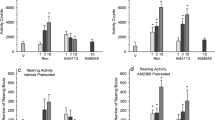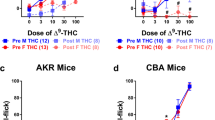Abstract
Rationale
The emergence of the consumption of highly potent synthetic cannabinoid receptor agonists (spice drugs) that produce important neurological symptoms has prompted the research on the consequences of acute and chronic use of these new psychoactive substances. Most studies on cannabinoid dependence have been performed in male animals, and there is a need of studies using female subjects.
Objectives
In the present study, we evaluated only in female animals the role of dopamine D1 receptors in the behavioral responses induced by acute and repeated stimulation of cannabinoid CB1 receptors, including the development of physical dependence, since cannabinoid CB1 receptors are co-localized with dopamine D1 receptors on GABAergic neurons projecting to the substantia nigra.
Methods
To this end, female dopamine D1 receptor-deficient mice and wild-type littermates were treated with HU-210, a potent synthetic cannabinoid agonist.
Results
Mutant mice displayed an enhanced response to acute motor and hypothermic effects to HU-210 when compared with wild-type females. The administration of SR141716A precipitated behavioral signs of withdrawal in mice treated subchronically with HU-210. Severity of cannabinoid withdrawal syndrome was potentiated in dopamine D1-deficient female mice. Indeed, 4 of 6 abstinence signs were increased in mutant mice.
Conclusions
These results support for a role of dopamine D1 receptors in the acute, chronic, and withdrawal actions of spice drugs.


Similar content being viewed by others
References
Adams AJ, Banister SD, Irizarry L, Trecki J, Schwartz M, Gerona R (2017) "zombie" outbreak caused by the synthetic cannabinoid AMB-FUBINACA in New York. N Engl J Med 376:235–242
Ameri A (1999) The effects of cannabinoids on the brain. Prog Neurobiol 58:315–348
Budney AJ, Hughes JR (2006) The cannabis withdrawal syndrome. Curr Opin Psychiatry 19:233–238
Castaneto MS, Gorelick DA, Desrosiers NA, Hartman RL, Pirard S, Huestis MA (2014) Synthetic cannabinoids: epidemiology, pharmacodynamics, and clinical implications. Drug Alcohol Depend 144:12–41
Chaperon F, Tricklebank MD, Unger L, Neijt HC (2003) Evidence for regulation of body temperature in rats by dopamine D2 receptor and possible influence of D1 but not D3 and D4 receptors. Neuropharmacology 44:1047–1053
Cox B, Lee TF (1978) Is acetylcholine involved in a dopamine receptor mediated hypothermia in mice and rats? Br J Pharmacol 62:339–347
EMCDDA (2017) Health and social responses to drug problems: a European guide. Publications Office of the EU, Luxembourg
EMCDDA (2020) https://www.emcdda.europa.eu/publications/drug-profiles/synthetic-cannabinoids_en
Festa ED, Jenab S, Weiner J, Nazarian A, Niyomchai T, Russo SJ, Kemen LM, Akhavan A, Wu HB, Quinones-Jenab V (2006) Cocaine-induced sex differences in D1 receptor activation and binding levels after acute cocaine administration. Brain Res Bull 68:277–284
Gessa GL, Melis M, Muntoni AL, Diana M (1998) Cannabinoids activate mesolimbic dopamine neurons by an action on cannabinoid CB1 receptors. Eur J Pharmacol 341:39–44
Hutcheson DM, Tzavara ET, Smadja C, Valjent E, Roques BP, Hanoune J, Maldonado R (1998) Behavioural and biochemical evidence for signs of abstinence in mice chronically treated with delta-9-tetrahydrocannabinol. Br J Pharmacol 125:1567–1577
Julian MD, Martin AB, Cuellar B, Rodriguez De Fonseca F, Navarro M, Moratalla R, Garcia- Segura LM (2003) Neuroanatomical relationship between type 1 cannabinoid receptors and dopaminergic systems in the rat basal ganglia. Neuroscience 119:309–318
Malyshevskaya O, Aritake K, Kaushik MK, Uchiyama N, Cherasse Y, Kikura-Hanajiri R, Urade Y (2017) Natural ((9)-THC) and synthetic (JWH-018) cannabinoids induce seizures by acting through the cannabinoid CB1 receptor. Sci Rep 7:10516
Martin AB, Fernandez-Espejo E, Ferrer B, Gorriti MA, Bilbao A, Navarro M, Rodriguez de Fonseca F, Moratalla R (2008) Expression and function of CB1 receptor in the rat striatum: localization and effects on D1 and D2 dopamine receptor-mediated motor behaviors. Neuropsychopharmacology 33:1667–1679
Martín-Calderón JL, Muñoz RM, Villanúa MA, del Arco I, Moreno JL, de Fonseca FR, Navarro M (1998) Characterization of the acute endocrine actions of (−)-11-hydroxy-delta8-tetrahydrocannabinol-dimethylheptyl (HU-210), a potent synthetic cannabinoid in rats. Eur J Pharmacol 344:77–86
Marusich JA, Craft RM, Lefever TW, Wiley JL (2015) The impact of gonadal hormones on cannabinoid dependence. Exp Clin Psychopharmacol 23:206–216
Nava F, Carta G, Gessa GL (2000) Permissive role of dopamine D(2) receptors in the hypothermia induced by delta(9)-tetrahydrocannabinol in rats. Pharmacol Biochem Behav 66:183–187
Ottani A, Giuliani D (2001) Hu 210: a potent tool for investigations of the cannabinoid system. CNS Drug Rev 7:131–145
Ovadia H, Wohlman A, Mechoulam R, Weidenfeld J (1995) Characterization of the hypothermic effect of the synthetic cannabinoid HU-210 in the rat. Relation to the adrenergic system and endogenous pyrogens. Neuropharmacology 34:175–180
Rinaldi-Carmona M, Barth F, Heaulme M, Shire D, Calandra B, Congy C, Martinez S, Maruani J, Neliat G, Caput D et al (1994) SR141716A, a potent and selective antagonist of the brain cannabinoid receptor. FEBS Lett 350:240–244
Rodriguez de Fonseca F, Rubio P, Menzaghi F, Merlo-Pich E, Rivier J, Koob GF, Navarro M (1996) Corticotropin-releasing factor (CRF) antagonist [D-Phe12,Nle21,38,C alpha MeLeu37]CRF attenuates the acute actions of the highly potent cannabinoid receptor agonist HU-210 on defensive-withdrawal behavior in rats. J Pharmacol Exp Ther 276:56–64
Rodríguez de Fonseca F, Carrera MR, Navarro M, Koob GF, Weiss F (1997) Activation of corticotropin-releasing factor in the limbic system during cannabinoid withdrawal. Science. 276:2050–2054
Rodriguez De Fonseca F, Gorriti MA, Bilbao A, Escuredo L, Garcia-Segura LM, Piomelli D, Navarro M (2001) Role of the endogenous cannabinoid system as a modulator of dopamine transmission: implications for Parkinson's disease and schizophrenia. Neurotox Res 3:23–35
Rubino T, Patrini G, Massi P, Fuzio D, Vigano D, Giagnoni G, Parolaro D (1998) Cannabinoid- precipitated withdrawal: a time-course study of the behavioral aspect and its correlation with cannabinoid receptors and G protein expression. J Pharmacol Exp Ther 285:813–819
Soria G, Castane A, Berrendero F, Ledent C, Parmentier M, Maldonado R, Valverde O (2004) Adenosine A2A receptors are involved in physical dependence and place conditioning induced by THC. Eur J Neurosci 20:2203–2213
van der Stelt M, Di Marzo V (2003) The endocannabinoid system in the basal ganglia and in the mesolimbic reward system: implications for neurological and psychiatric disorders. Eur J Pharmacol 480:133–150
Trexler KR, Nass SR, Crowe MS, Gross JD, Jones MS, McKitrick AW, Siderovski DP, Kinsey SG (2018) Novel behavioral assays of spontaneous and precipitated THC withdrawal in mice. Drug Alcohol Depend 191:14–24
Wakley AA, McBride AA, Vaughn LK, Craft RM (2014) Cyclic ovarian hormone modulation of supraspinal Delta9-tetrahydrocannabinol-induced antinociception and cannabinoid receptor binding in the female rat. Pharmacol Biochem Behav 124:269–277
Xu M, Moratalla R, Gold LH, Hiroi N, Koob GF, Graybiel AM, Tonegawa S (1994) Dopamine D1 receptor mutant mice are deficient in striatal expression of dynorphin and in dopamine-mediated behavioral responses. Cell 79:729–742
Zhang Y, Guo J, Guo A, Li Y (2016) Nicotine-induced acute hyperactivity is mediated by dopaminergic system in a sexually dimorphic manner. Neuroscience 332:149–159
Funding
This work was supported by Red de Trastornos Adictivos, Instituto de Salud Carlos III and European Regional Development Funds-European Union (RD16/0017/001 to F.R.F); Ministerio de Economía y Competitividad, Instituto de Salud Carlos III and European Regional Development Funds-European Union (PI19/01755 to F.R.F and PI17/02026 to A.S); and Plan Nacional sobre Drogas and Ministerio de Sanidad, Servicios Sociales e Igualdad (PND2019/040, PND2018/044, PND2018/033, PND2017/043). AS, FJP and JS hold Miguel Servet research contracts funded by Instituto de Salud Carlos III and European Regional Development Funds-European Union (CP14/00173 to A.S, CP14/00212 to F.J.P and CPII17/00024 to J.S.).
Author information
Authors and Affiliations
Corresponding authors
Ethics declarations
Conflict of interest
The authors declare that they have no conflict of interest.
Additional information
Publisher’s note
Springer Nature remains neutral with regard to jurisdictional claims in published maps and institutional affiliations.
Rights and permissions
About this article
Cite this article
Serrano, A., Vadas, E., Ferrer, B. et al. Genetic deletion of dopamine D1 receptors increases the sensitivity to cannabinoid CB1 receptor antagonist-precipitated withdrawal when compared with wild-type littermates: studies in female mice repeatedly exposed to the Spice cannabinoid HU-210. Psychopharmacology 238, 551–557 (2021). https://doi.org/10.1007/s00213-020-05704-8
Received:
Accepted:
Published:
Issue Date:
DOI: https://doi.org/10.1007/s00213-020-05704-8




